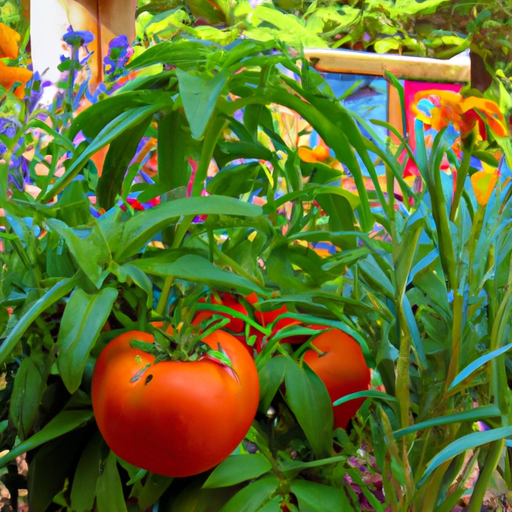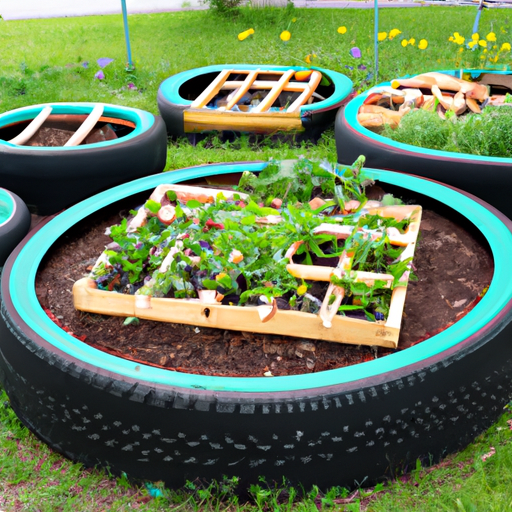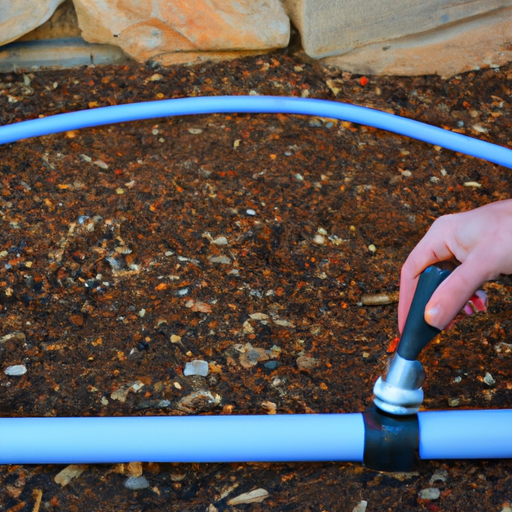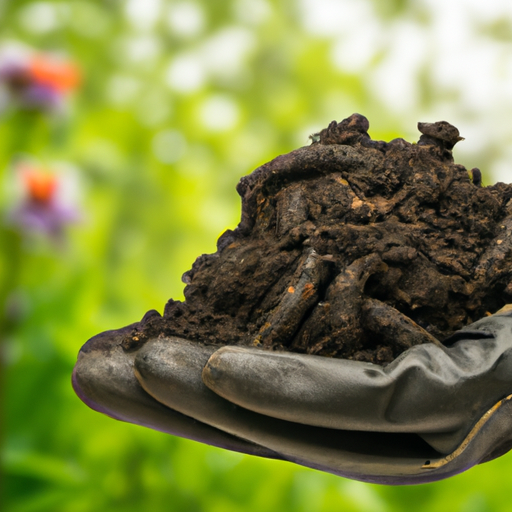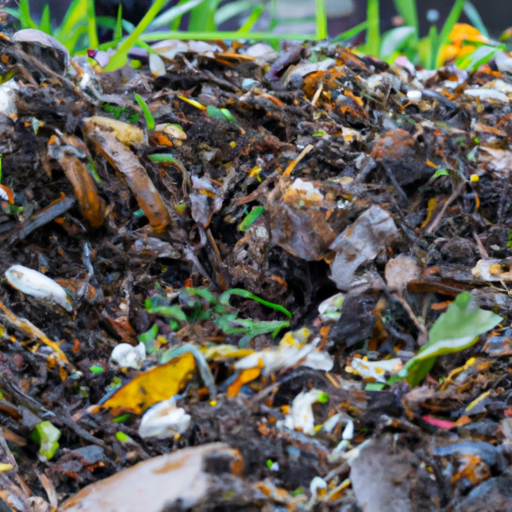If you’re an avid gardener, then you know that planting tomatoes is a must-have in your garden. Tomatoes are not only delicious but also easy to grow and maintain. However, did you know that companion planting can enhance the growth and flavor of your tomato plants?
In this article, we’ll explore the best companion plants for tomatoes. Companion planting involves strategically planting different crops together to benefit each other’s growth and health while reducing pests and diseases. The right companions for tomatoes can help improve soil fertility, attract beneficial insects, repel harmful pests, and even provide shade or support for the plant.
So let’s dive into some of the top companion plants that will take your tomato gardening game to the next level!
Understanding Companion Planting
Companion planting is a gardening technique that involves growing different plants together for mutual benefits.
Companion planting benefits include increased biodiversity, natural pest control, improved soil health, and higher yields.
However, there are common misconceptions about companion planting, such as the belief that certain plants repel pests or attract beneficial insects without scientific evidence to support these claims.
It’s important to understand the principles behind companion planting and choose appropriate plant combinations based on factors such as soil type, sun exposure, and water requirements.
By practicing effective companion planting techniques, gardeners can create a healthy and harmonious ecosystem in their gardens while maximizing crop production.
Improving Soil Fertility
Now that we’ve explored the benefits of companion planting, let’s focus on how to improve soil fertility for your tomato plants.
Did you know that using cover crops can greatly enhance soil health? Cover crops such as legumes, grasses, and clovers help fix nitrogen in the soil and suppress weeds.
Another effective method is composting techniques which allows organic matter to decompose into a nutrient-rich fertilizer. You can create your own compost by adding kitchen scraps, yard waste, and even livestock manure into a bin or pile.
By incorporating these practices into your gardening routine, you’ll not only nourish your tomato plants but also promote a healthy ecosystem in your garden.
As Master Gardeners, it’s important to understand the value of maintaining sustainable agriculture through responsible farming practices.
Attracting Beneficial Insects
To truly care for your tomatoes, it’s important to consider the beneficial insects that can help protect them. Attracting these helpful bugs is a great way to keep pests at bay and promote healthy growth in your garden. One effective method is by planting pollinator friendly flowers such as marigolds, zinnias, and sunflowers nearby. This will attract bees and other pollinators who will not only aid in tomato production but also benefit the entire ecosystem of your garden. Additionally, companion herbs like basil, oregano, or parsley can be planted alongside tomatoes to enhance their flavor while deterring harmful insects. As you plan out your vegetable garden this season, remember to prioritize attracting beneficial insects with these simple yet effective methods!
Repelling Harmful Pests
As a Master Gardener, it’s important to protect your tomato plants from harmful pests. Fortunately, there are natural repellents you can use to keep them away.
One option is companion herbs such as basil, mint, and marigolds that emit strong scents that repel pests like aphids, spider mites, and whiteflies.
Another effective method is using homemade solutions made with ingredients like garlic, hot pepper flakes or soap mixed with water to spray on the leaves of your tomato plant. These sprays will not harm the plant but still deter unwanted insects from feasting on your tomatoes.
Remember to always read up on any new methods before trying them out in your garden!
Providing Shade And Support
Now that we’ve discussed how to repel harmful pests, let’s talk about providing shade and support for your tomato plants.
One way to provide both of these things is by interplanting herbs such as basil or cilantro with your tomatoes. These herbs not only add flavor to your meals but also help keep some pests away from your tomatoes. Plus, they can provide a bit of shade for the lower parts of your tomato plant on hot summer days.
Another important aspect of supporting your tomato plants is choosing an appropriate trellis. This will not only give your plants something to climb up but will also prevent them from sprawling all over the ground where they are more susceptible to diseases and pests. There are many different types of trellises available so be sure to choose one that fits in with the style and needs of your garden space.
Remember, healthy tomato plants mean delicious fruits at harvest time!
Frequently Asked Questions
Do Companion Plants Have Any Effect On The Taste Of The Tomatoes?
Are you curious about the impact of companion planting on tomato flavor?
Many gardeners believe that certain plants can enhance the taste of tomatoes, but is there any scientific evidence to support this claim?
As a Master Gardener, I have researched extensively on this topic and found that while some studies suggest that companion planting may improve tomato taste by deterring pests or providing necessary nutrients, others have shown no significant effect.
Ultimately, it’s important to remember that many factors contribute to the flavor of your tomatoes, including soil quality, watering practices, and plant variety.
While incorporating complementary plants into your garden can certainly benefit your overall harvest, don’t rely solely on companion planting for a delicious crop – focus on creating optimal growing conditions for your tomatoes as well.
Can I Plant Other Vegetables Alongside Tomatoes As Companion Plants?
When it comes to planting tomatoes, intercropping with other vegetables can bring numerous benefits. Not only does it maximize space and yield, but also improves soil health by reducing pest and disease pressure.
However, there are some common mistakes to avoid when selecting companion plants for your tomatoes. Firstly, avoid planting members of the same family, such as peppers or eggplants, which may compete for nutrients and increase susceptibility to diseases. Secondly, choose plants that have similar water and light requirements as tomatoes to ensure they thrive together.
Overall, intercropping is a great way to get more out of your garden while creating a diverse and healthy ecosystem.
How Many Companion Plants Should I Plant Per Tomato Plant?
When it comes to companion planting, the ideal spacing for each tomato plant is crucial. As a Master Gardener, I always recommend planting at least one or two companion plants per tomato plant.
Not only does this promote healthy growth and deter pests, but it also maximizes space in your garden. Planting techniques are equally important – be sure to choose plants that have similar water and sunlight requirements as your tomatoes.
By following these tips, you’ll create a thriving ecosystem in your garden while reaping the benefits of bountiful harvests. Remember: just like how we need friends to thrive, so do our beloved tomato plants!
Are There Any Companion Plants That Should Be Avoided When Planting With Tomatoes?
When planting tomatoes, it’s important to consider the negative effects of incompatible companion plants.
Companion plants that should be avoided with tomatoes include members of the nightshade family such as peppers and eggplants, which can all attract similar pests and diseases.
Other plants like fennel and dill can stunt tomato growth due to their allelopathic properties.
It’s crucial to choose compatible companions for your tomato plants in order to promote healthy growth and avoid any potential setbacks.
As a Master Gardener, I recommend researching thoroughly before pairing any plants together to ensure a successful harvest.
How Do I Know If A Particular Plant Is A Good Companion For Tomatoes?
When it comes to planting tomatoes, choosing the right companion plants can make all the difference.
To determine if a plant is a good companion for your tomato plants, consider its growth habits and nutritional needs.
Look for plants that complement or supplement the nutrients needed by tomato plants, such as basil, marigolds, and chives.
These companion plants not only add beauty to your garden but also provide benefits like pest control and improved soil health.
By understanding how to choose companion plants for tomatoes, you can create a thriving ecosystem in your garden that supports healthy growth and abundant harvests.
Conclusion
As a Master Gardener, I can tell you that selecting the right companion plants for your tomatoes is crucial to their growth and overall health.
Not only do these plants help deter pests and attract beneficial insects, but they can also improve soil quality and enhance yield.
But here’s the thing – not all companion plants are created equal. Some may even harm your tomato plants if planted too close together.
So, it’s important to do your research and select the best companions based on what works well in your particular region or climate. Trust me, taking the time to choose wisely will pay off with plump, juicy tomatoes that burst with flavor!
